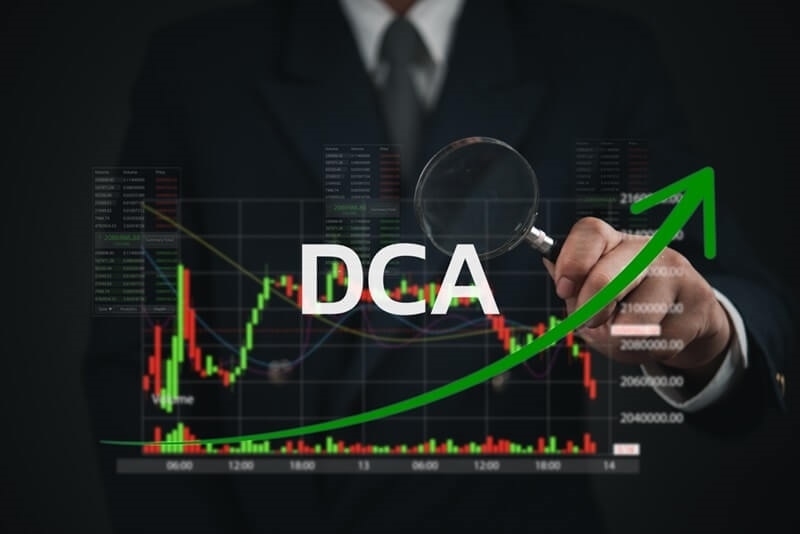
Investing in the constantly changing markets of today can be daunting, especially when the market is in overdrive. If you've ever feared missing the perfect time to get in the market, don't worry, you're not alone. That's where intelligent dollar cost averaging strategies enter the picture.This systematic approach to investing mitigates market risk, contributes to wealth accumulation over time, and protects you against emotional investing. Whether you are a novice investor or looking to improve a portfolio, it is useful to educate yourself on dollar cost averaging, the DCA investment method, and how to build a regular investment plan to keep it consistent in volatile markets.
Dollar cost averaging (DCA) is a strategy of long-term investment where the investor splits the amount to be invested into purchases over a period of time for the desired asset. Through this strategy, one hedges against the effect of volatility in the market since more is bought at times when the price is lower and less when the price is higher. In the long run, one ends up with a lower average cost per share, thus the name "averaging."
Rather than attempting to time the market, DCA emphasizes time in the market, particularly useful in volatile market cycles.

The reason the DCA investment strategy is favored is because of its simplicity, accessibility, and risk profile. Below are several reasons why it continues to be favored, especially in uncertain times:
Fear and greed typically lead investors to buy at highs and panic sell at dips. DCA reduces emotion by simply buying, no matter what the market moves are doing.
While you can ride out volatility in the market with lump sum investing, you might also be at risk of significant short-term losses. By employing DCA, you are able to spread this risk over time and reduce volatility swings.
Establishing a predictable investment plan using DCA builds positive money behaviors. Technically, every week, month, or quarter you make an automatic investment, and you transition to a habit.
Over the long term, DCA investors will usually find that they paid a lower average buying price based on market pricing than had they invested their lump sum principal investment at its peak.
For illustrative purposes, let's say you invest $6000 into a mutual fund or ETF. Rather than putting the lump sum into the fund, you use DCA, and spread the investment into 12 installments, investing $500 each month.
For example, if you decide to invest $500 each month in a stock dollar cost averaging, in January, the stock price is $50 per share, you buy 10 shares. In February, the stock price fell to $40, and you bought 12.5 shares. In March, the stock price goes up to $60, and you buy 8.33 shares. In April, the stock price drops to $30, and you buy 16.66 shares. If you did this process until November, then in December, with a share price of $55, you will buy 9.09 shares. This example shows that dollar cost averaging allows the investor to average the cost per share through volatile markets effectively.
For example, your dollar cost averaging figures show how buying at different price points averages down your cost basis and lowers your exposure to short-term peak selling pressure.
When there is uncertainty in the market and a rally or collapse is underway, indecision can affect behavior. That is when dollar cost averaging shines. Here is the best way to use it:
Stick with diversified index funds or blue-chip stocks, or ETFs. Don't chase returns by investing in very speculative positions in volatile markets for anything other than extremely risk-tolerant investors.
Use your brokerage portal to set up auto-investments on a monthly, quarterly basis, whichever fits your preference. This removes the decision-making pressure, maintains your steady investments, and keeps the plan on course.
One of the worst things an investor can do is stop investing and contributing when it seems like the market is in a free fall! Ironically, those are the times when DCA is most useful — purchasing more units at lower prices.
Dollar cost averaging is not for short-run speculating. The secret to success is to be persistent over months and years, even when the market becomes turbulent.
The average down strategy is a close relative of dollar cost averaging. It entails buying more of an asset after the price has fallen to lower the average cost of your position.
Both the strategies are designed to decrease the cost basis and can even be utilized together for sophisticated investing, particularly when the investor is highly convinced about a specific stock or asset.
Here are some intelligent dollar cost averaging methods that you can begin with immediately to enhance your investment habit:
If you have a big amount available, think of investing a part upfront and the remaining through DCA. This exposes you to the market to some extent with the flexibility still intact.
While DCA eschews market timing, you can enhance your strategy by keeping an eye on market valuations. If you know that there is extreme overvaluation or undervaluation, you can bias your DCA amount a bit (but not significantly).
While consistency is paramount, it's also a good idea to examine your plan. If your income rises, market conditions change, or financial objectives shift, you can increase your contributions.
Automatic dividend reinvestment is supported by most platforms. This introduces a second level of dollar cost averaging, allowing you to build additional shares with your returns.
It's also important to note the limitations of DCA. In the past, lump-sum investing tends to dominate DCA in bull markets merely because the market usually goes up over time. But investing in volatile markets makes DCA a far more secure and psychologically tolerable strategy.
Dollar cost averaging is well suited to unpredictable or volatile markets, as it minimizes the potential of negative timing and makes investing a more systematic activity over time. It effectively lessens emotional decision making and provides consistency by staggering investments over a period of time. One of the disadvantages of dollar cost averaging is that if the market is rapidly increasing over time, then it is more likely to be lagging behind because funds are only partially invested for a period of time in the initial investment strategy.
Lump-sum investing, on the other hand, is best suited toward a stable or upward trending market, where an investor has a large amount of money, and wants to consider putting it to work all at once. Lump-sum investing tightly aligns with most investor's intentions when they are investing, as it allows them to maximize their potential gains. However, the downside with lump-sum investing is once the amount is invested; if the market transitions downward, the potential loss from that investment is much higher than potential losses if a partial amount is dollar cost averaged into the market.
The only thing disciplined investment plans are built around is financial discipline.. Here's how to create one with DCA:
What are you investing in? Retirement? Down payment on a house? Your goals decide your time horizon and risk tolerance.
Choose an amount that is comfortable for your wallet. It's better to be small and consistent than to be big and drop out.
Pick an index fund, diversified ETF, or mutual fund that works with your risk profile, as long as it has the lowest cost and history of consistent results.
Set it, and forget it. Trust the process. Don't check it daily, focus on the long-term movement, don't listen to short-term noise!
Volatility in the market is certain. But there is no reason for your response to be uncertain. You are using a prudent, time-tested investment strategy based on consistency and discipline called intelligent dollar cost averaging strategies to reduce market risk in those times of volatility.
In an era of outrageous headlines and fear that creates uncertainty, you can rise above the noise and ignore the sensational news by being calm and investing wisely. Maintain a strong DCA investment plan, settle your emotions, and think as far into the future as you can.
This content was created by AI